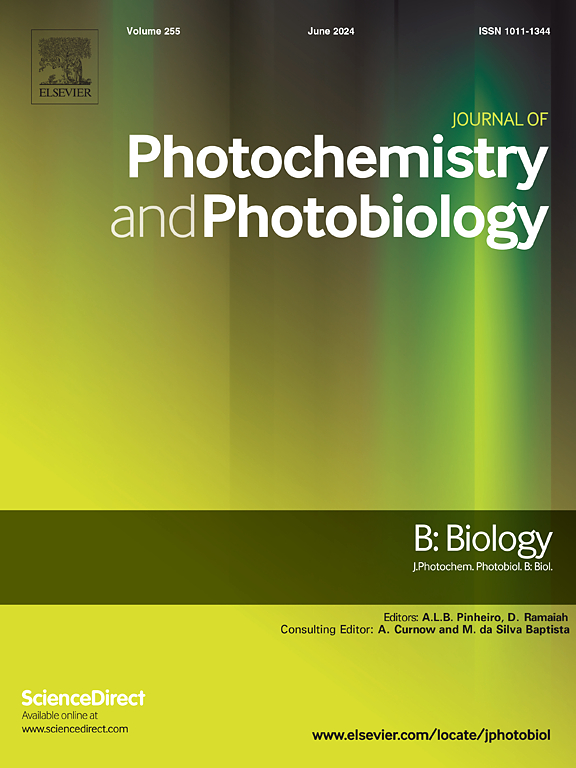Fabrication of highly biocompatible SiO2@Au-BSA nanoconjugates: Towards a promising thermal therapy route
IF 3.9
2区 生物学
Q2 BIOCHEMISTRY & MOLECULAR BIOLOGY
Journal of photochemistry and photobiology. B, Biology
Pub Date : 2024-11-12
DOI:10.1016/j.jphotobiol.2024.113064
引用次数: 0
Abstract
SiO2@Au nanoshells have gained relevance in recent years, especially in biomedical areas, acting as thermal therapy agents due to their high capacity to absorb light and transform it into heat that increases the temperature of the medium. Therefore, it is important to develop methodological strategies to obtain stable, highly specific and biocompatible nanoparticles. In this work, the synthesis of core-shell structures based on SiO2@Au is reported, where the growth a thin shell ⁓ 46 nm on silica platform was possible. Subsequently, optimal conditions were developed for the binding of a bovine serum albumin (BSA) protein using a thiolated linker such as mercaptoethanol. Likewise, the photothermal conversion capacity was investigated using thermal lens spectroscopy. Thermal diffusivity values were reported for the first time during the conjugation process of gold nanoshells, where an increase of 37.5 % was recorded as the conjugation was completed. Finally, the cytotoxic potential of the developed nanoconjugates was evaluated through their hemolytic rate in human red blood cells. The findings suggest high hemocompatibility of the SiO2@Au-BSA complex because they did not cause significant oxidative stress and are classified as nonhemolytic. Therefore, in this work we propose a synthesis route for a thermal agent based on SiO2@Au and bovine serum albumin, highly biocompatible and with high photothermal conversion. The results of this work aim to clarify the safety of using gold nanoshells as a thermal therapy agent.
制备高生物相容性的 SiO2@Au-BSA 纳米共轭物:迈向前景广阔的热疗之路
近年来,SiO2@Au 纳米壳因其吸收光并将其转化为热量从而提高介质温度的能力极强而成为热疗剂,在生物医学领域尤其如此。因此,开发获得稳定、高特异性和生物相容性纳米粒子的方法策略非常重要。在这项工作中,报告了基于 SiO2@Au 的核壳结构的合成,在二氧化硅平台上可以生长出 46 纳米的薄壳。随后,利用硫醇连接剂(如巯基乙醇)开发出了结合牛血清白蛋白(BSA)蛋白质的最佳条件。同样,还利用热透镜光谱法研究了光热转换能力。首次报告了金纳米壳共轭过程中的热扩散值,共轭完成后,热扩散值增加了 37.5%。最后,通过纳米共轭物在人类红细胞中的溶血率评估了其细胞毒性潜力。研究结果表明,SiO2@Au-BSA 复合物具有很高的血液相容性,因为它们不会引起明显的氧化应激,被归类为非溶血性。因此,在这项工作中,我们提出了一种基于 SiO2@Au 和牛血清白蛋白的热敏剂的合成路线,这种热敏剂具有很高的生物相容性和光热转换率。这项工作的成果旨在阐明使用金纳米壳作为热疗剂的安全性。
本文章由计算机程序翻译,如有差异,请以英文原文为准。
求助全文
约1分钟内获得全文
求助全文
来源期刊
CiteScore
12.10
自引率
1.90%
发文量
161
审稿时长
37 days
期刊介绍:
The Journal of Photochemistry and Photobiology B: Biology provides a forum for the publication of papers relating to the various aspects of photobiology, as well as a means for communication in this multidisciplinary field.
The scope includes:
- Bioluminescence
- Chronobiology
- DNA repair
- Environmental photobiology
- Nanotechnology in photobiology
- Photocarcinogenesis
- Photochemistry of biomolecules
- Photodynamic therapy
- Photomedicine
- Photomorphogenesis
- Photomovement
- Photoreception
- Photosensitization
- Photosynthesis
- Phototechnology
- Spectroscopy of biological systems
- UV and visible radiation effects and vision.

 求助内容:
求助内容: 应助结果提醒方式:
应助结果提醒方式:


